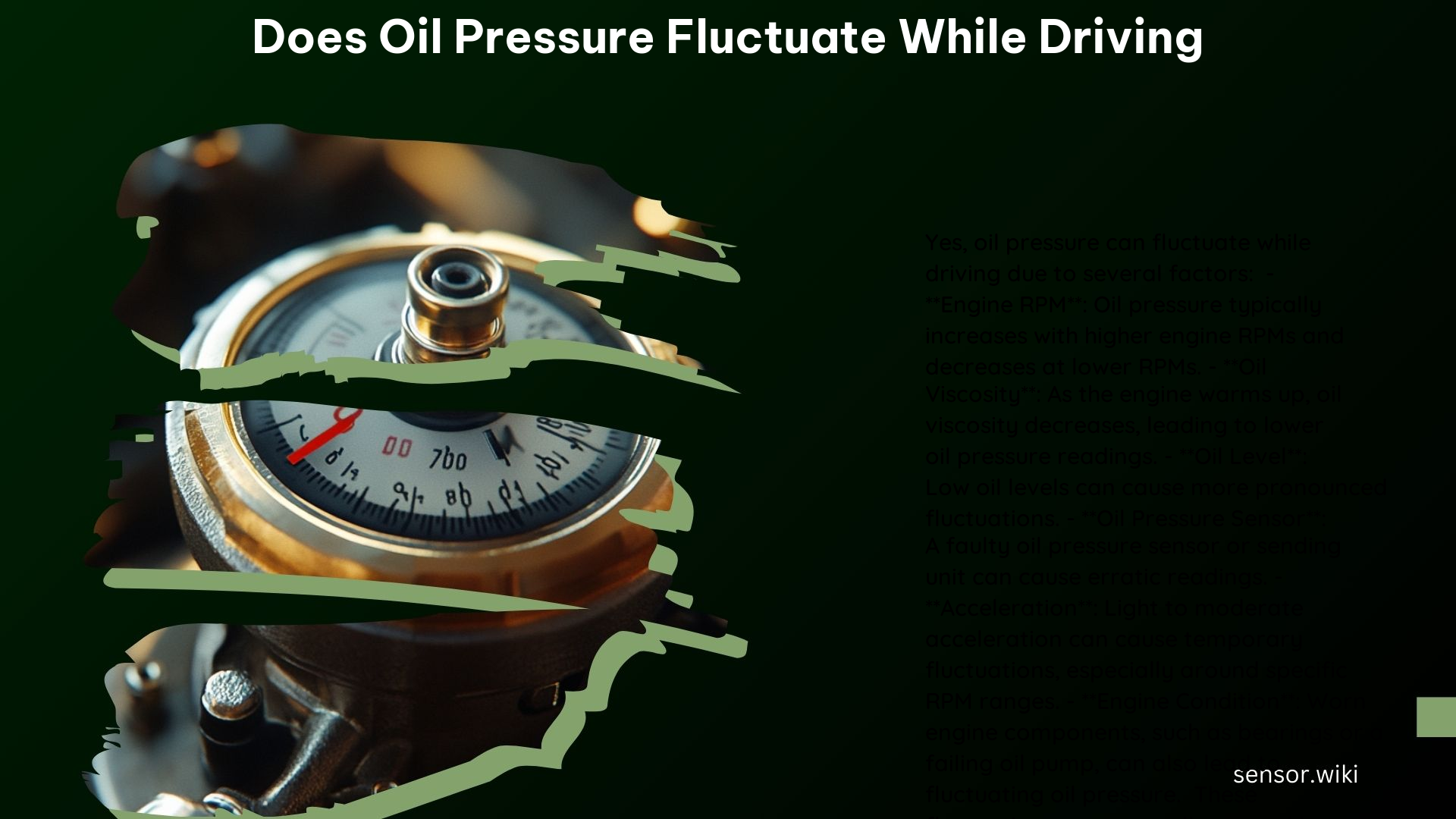The oil pressure in a vehicle’s engine can fluctuate while driving, and understanding the reasons behind these fluctuations is crucial for maintaining the engine’s health and preventing potential issues. In this blog post, we will explore the behavior of the oil pressure gauge, the factors that can cause oil pressure fluctuations, and the steps to diagnose and address any concerns.
What is the Typical Behavior of the Oil Pressure Gauge?
Under normal conditions, the oil pressure gauge in a vehicle like a Silverado should display stable readings that vary predictably with engine speed and temperature. Here’s what you can typically expect:
- Idle: Oil pressure should be around 10-20 psi when the engine is idling and warm.
- Higher RPMs: As the engine RPM increases, oil pressure typically rises. For example, at 3000 RPM, the pressure should be at least 40-50 psi.
- Temperature Influence: Oil pressure can decrease as the engine oil warms up due to the reduction in oil viscosity.
What Factors Can Cause Oil Pressure Sensor Fluctuations?

Several factors can cause the oil pressure sensor to fluctuate while driving:
- Faulty Oil Pressure Sensor or Sending Unit: A defective sensor can send erratic signals to the gauge, causing fluctuations. This is often due to a buildup of crud or oil on the sensor or issues with the wiring connections.
- Mechanical Issues: Problems such as a worn oil pump, clogged oil filter, or worn engine bearings can lead to unstable oil pressure readings.
- Viscosity Changes: The viscosity of the oil changes with temperature, which can affect pressure readings. Thicker oil at lower temperatures can result in higher pressure readings, while thinner oil at higher temperatures can result in lower readings.
- Electrical Issues: Faulty wiring or connections can interrupt the signal from the sensor to the gauge, causing fluctuations.
What is the Difference Between Normal and Concerning Fluctuations?
- Normal Fluctuations: It is normal for oil pressure to fluctuate slightly with changes in engine speed and temperature. However, these fluctuations should be within a predictable range and not erratic.
- Example: A slight drop in pressure as the engine warms up or a rise in pressure with increased RPM is normal.
- Concerning Fluctuations: Erratic or large fluctuations, especially those that do not follow the expected pattern, can indicate a problem.
- Example: If the gauge needle bounces erratically between high and low readings, or if the pressure drops significantly with acceleration, it could indicate a mechanical or sensor issue.
How Can Oil Pressure Fluctuate During Acceleration?
During acceleration, several mechanical and fluid dynamics factors can influence oil pressure readings:
- Pressure Relief Valve: The oil pump’s pressure relief valve can open and close as the engine load changes, causing temporary fluctuations in oil pressure.
- Engine Load: Increased engine load during acceleration can cause the oil pump to work harder, potentially leading to temporary pressure spikes or drops.
- Oil Viscosity: As the engine accelerates, the oil’s viscosity may change due to temperature and shear stress, affecting pressure readings.
How to Diagnose Oil Pressure Fluctuations During Acceleration?
To diagnose oil pressure fluctuations during acceleration, consider the following steps:
- Check Oil Level: Ensure the oil level is adequate, as low oil levels can cause pressure fluctuations.
- Inspect Sensor and Wiring: Check the oil pressure sensor and its connections for any signs of damage or corrosion.
- Use a Separate Oil Pressure Gauge: Install a separate gauge to verify the readings from the existing sensor. This can help determine if the issue is with the sensor or the gauge itself.
- Check for Mechanical Issues: Look for signs of mechanical problems such as worn bearings, a clogged oil filter, or a failing oil pump. This may involve inspecting the engine oil for metal particles or shavings.
- Consult Specifications: Refer to the vehicle’s specifications for expected oil pressure readings at different engine speeds and temperatures.
What Tools and Products are Needed for Technical Troubleshooting?
To diagnose and address oil pressure fluctuations, you may need the following tools and products:
- Oil Pressure Gauge: A separate, calibrated gauge to verify readings.
- Multimeter: To check electrical connections and wiring.
- Engine Oil Analysis Kit: To inspect for metal particles or shavings in the engine oil.
What are the Typical Costs and Schedules for Repairs?
- Replacing the Oil Pressure Sensor: This is typically a low-cost repair, often under $100, and can be done in a few hours.
- Mechanical Repairs: Costs can vary widely depending on the specific issue. For example, replacing a worn oil pump could cost several hundred dollars and require several hours of labor.
In conclusion, oil pressure fluctuations while driving can be caused by a variety of factors, ranging from faulty sensors to mechanical issues. By understanding the typical behavior of the oil pressure gauge, identifying the root causes, and following the appropriate diagnostic steps, you can effectively address any concerns and maintain the health of your vehicle’s engine.
References
- YouTube: Oil Pressure Needle Bouncing Up and Down – This video explains common causes of oil pressure gauge fluctuations, including faulty sensors and mechanical issues.
- Mustang6G Forums: Oil Pressure Fluctuation on Acceleration – This discussion highlights the potential causes of oil pressure fluctuations during acceleration, including the role of the pressure relief valve.
- Car Talk Community: Oil Pressure Gauge Fluctuating – This thread provides insights into diagnosing and troubleshooting oil pressure gauge issues, including the use of separate gauges and checking electrical connections.
